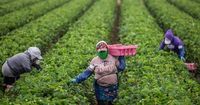In the wake of a sweeping federal crackdown on immigrants and unhoused residents, communities from Washington, D.C. to Southern California are grappling with the profound human and economic consequences of President Trump’s latest immigration enforcement surge. As local aid networks race to meet surging needs, tragic incidents and mounting economic disruptions highlight the far-reaching effects of the administration’s policies.
On August 14, 2025, a fatal incident in Monrovia, California, underscored the fear and chaos now shadowing immigrant communities. According to the Associated Press, a man fleeing U.S. Immigration and Customs Enforcement (ICE) agents outside a Home Depot store ran across the lanes of eastbound Interstate 210 and was struck by an SUV traveling at 50 to 60 miles per hour. He was transported to a hospital, where he died. His identity has not yet been released, pending notification of his family. Monrovia City Manager Dylan Feik expressed condolences, stating, “We extend our condolences for the individual and his family.” The California Highway Patrol is investigating the crash, and a spokesperson for the Department of Homeland Security asserted, “This individual was not being pursued by any DHS law enforcement.”
This tragedy is not an isolated case. Just weeks prior, a farmworker fell from a greenhouse roof during an immigration raid at a cannabis facility northwest of Los Angeles and died from his injuries. Advocates have responded with vigils and public denouncements of the widespread raids that have become a hallmark of Trump’s renewed immigration enforcement efforts. The Los Angeles Times reports that arrests have been recorded at Home Depot stores, car washes, garment factories, and other worksites throughout Southern California, fueling pervasive fear among immigrant populations. A federal court in Southern California has temporarily blocked indiscriminate sweeps, with a hearing set for September.
Meanwhile, in the nation’s capital, the atmosphere is equally tense. As Axios detailed on August 15, 2025, Washington, D.C.’s aid network has surged in response to “President Trump’s federal crackdown targeting immigrants and unhoused residents.” The DC Migrant Solidarity Mutual Aid Network’s ICE hotline has been overwhelmed with calls for help—yet, notably, the organization has also seen a groundswell of community support. Amy Fischer, a spokesperson for the group, told Axios, “The D.C. community is responding in the best way we can imagine.” She described how many immigrants are now afraid to go about their daily lives—whether driving, shopping, or working—due to the risk of ICE stops. “People are standing up—not only showing up at checkpoints, but providing aid, food, rides and safety,” Fischer said.
To meet the growing demand, the DC Migrant Solidarity Mutual Aid Network is training new volunteers to expand hotline services and is actively recruiting more helpers. Miriam’s Kitchen, a nonprofit focused on combating homelessness, is now serving about 200 people per meal and seeking donations of ground coffee to keep up with the demand. Martha Wolf, a volunteer organizer at Miriam’s Kitchen, shared, “The great uncertainty about what’s happening makes it hard to have a plan. Our biggest message: We’ll continue helping our guests, and we invite people to join us.”
Other organizations stepping up include Ward 1 Mutual Aid, which delivers groceries and supplies to neighborhoods like Columbia Heights and Petworth; Ayuda, offering legal services and social programs to immigrants; Amica, connecting asylum seekers and migrants with housing and basic needs; Remora House, providing tents and sanitary products to the unhoused; the Washington Legal Clinic for the Homeless, offering free legal help; and Horton’s Kids, supporting children in under-resourced communities with tutoring and mentoring. Each group is adapting quickly, seeking volunteers and donations to fill critical gaps left by the federal crackdown.
The consequences of these enforcement actions are not limited to humanitarian concerns—they are rippling through the American economy as well. NBC News reports that, as of August 15, 2025, the nation is experiencing a dramatic 38.9% increase in wholesale dry and fresh vegetable prices from June to July, the largest such spike since March 2022. Phil Kafarakis, president of IMFA The Food Away From Home Association, warned, “You are now going to be left with not enough laborers in the fields to pick up and collect product as its coming to harvest.” He added that the deportation efforts are compounding the “horribly, incredibly impactful” effects of tariffs, drought, flooding, and wildfires, all of which threaten to further disrupt late summer and early fall harvests.
The Bureau of Labor Statistics and the Dallas Federal Reserve have both noted that labor shortages in agriculture and related industries are leading to slowdowns and rising prices. ICE arrests in June 2025 reached their highest monthly total in at least five years, and the Dallas Fed’s latest survey found that Texas businesses are struggling to hire qualified workers due to immigration policy uncertainty. One machine manufacturer told the Fed, “Foreign-born laborers get the job done. We need them, we use them, and we like them.”
Texas, in particular, has seen a sharp increase in its reliance on immigrant workers. According to the Dallas Federal Reserve, the share of Texas firms depending on workers from other countries rose from 15% in 2023 to 25% in 2024, with about a third of manufacturing respondents relying on immigrant labor. However, the cycling of immigrant workers in and out of the country has all but stopped, and the number of foreign-born workers in the U.S. fell by about 1.2 million from January to July 2025, as calculated by the National Foundation for American Policy. Stuart Anderson, the foundation’s executive director, noted, “The reason why you see slowdowns is because when employers can’t find enough workers, they are going to invest less.”
Robert Lynch, an economics professor at Washington College and co-author of a recent America’s Voice report, said that agricultural employment dropped by 155,000 workers—down 6.5%—between March and July 2025, a stark reversal from the previous two years. Construction and hospitality sectors, which also rely heavily on immigrant labor, are experiencing similar slowdowns, with high-immigrant states showing much lower job growth than their counterparts.
Antonio De Loera-Brust, spokesperson for United Farm Workers, challenged the narrative of labor shortages, saying, “A lot of workers I talk to are desperate for work. There’s not enough work.” He added that hours are being cut and workers are being asked to do in six hours what used to take eight, suggesting that some growers might be using the disruptions caused by raids to push for more guest workers at lower wages. “We are dead set against deportations,” De Loera-Brust emphasized.
President Trump, facing pressure from agricultural businesses, has oscillated between pausing and resuming raids in key industries and is now reportedly considering temporary passes for certain workers. The administration’s actions have left many businesses and workers in limbo, with no clear resolution in sight.
As the nation enters the late summer harvest and a new school year, the effects of the crackdown are visible on dinner tables, in local shops, and on the streets where aid groups scramble to fill growing needs. The coming months will test the resilience of both communities and the economy as they navigate the uncertain landscape shaped by these federal policies.


